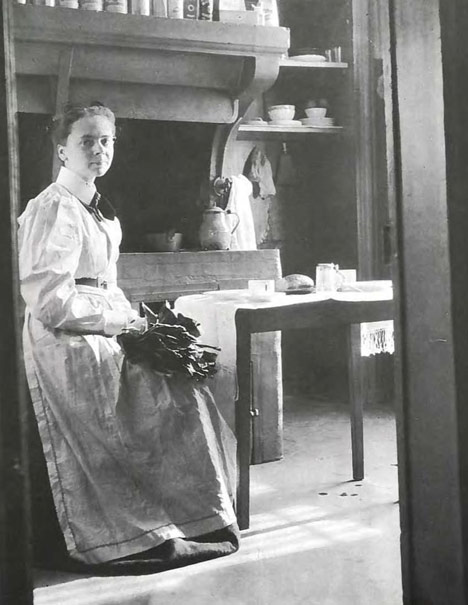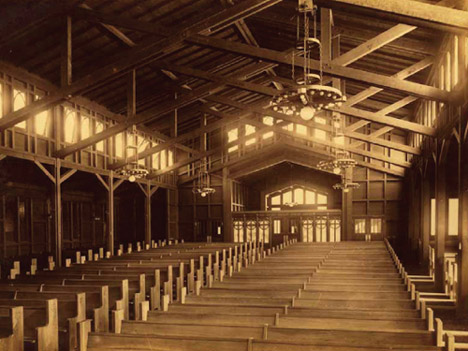
Julia Morgan becomes first woman to receive AIA Gold Medal
News: the American Institute of Architects has named Californian architect Julia Morgan as the first female recipient of the AIA Gold Medal, 56 years after her death.
Julia Morgan (1872-1957), whose best-known buildings include the Hearst Castle mansion in San Simeon (main image) and St. John's Presbyterian Church in Berkeley, will posthumously becomes the first woman to receive the AIA's highest accolade in the 107-year history of the programme.
After being the first woman to study architecture at the Ecoles des Beaux-Arts in Paris, Morgan became California's first licensed female architect in 1904. She then went on to design over 700 buildings, including houses, museums, churches, hotels and offices, in a variety of different historical styles that included Tudor, Georgian and Spanish colonial.
"She designed buildings to fit her clients, blending design strategy with structural articulation in a way that was expressive and contextual, leaving us a legacy of treasures that were as revered when she created them as they are cherished today," wrote architect Michael Graves in a recommendation letter.

The news comes just six months after the jury of the Pritzker Prize refused to retrospectively recognise Denise Scott Brown for the award her husband and partner Robert Venturi received in 1991, fuelling speculation that the choice of recipient is a direct response to this decision.
Architecture critic Alexandra Lange commented via Twitter: "There's only one other case of awarding [the medal] to a long-dead person. Morgan, who is deserving, is an anodyne choice for the first woman to get the medal. She would not have been during her lifetime."
However AIA board member Julia Donoho told Architect magazine that she began her search for "the first women to win the Gold Medal" when she joined the board a year ago. Donoho said she nominated Morgan because she felt that the organisation needed to go back in time and recognise female architects who "were overlooked".
Scott Brown, who also recommended Morgan, said: "Her work mirrored the social and economic burgeoning of California and the changing roles of women. Now that we are taking off our blinders, we can see Morgan's greatness. Including her now will help the profession diversify its offerings to include greater richness and creativity of expression."
"Her story tells us not to look at her gender, but to look at her work," added Frank Gehry in his own recommendation letter. "Her projects are personal, distinctive, and were built in a lasting and sustainable manner."

Morgan is the 70th recipient of the Gold Medal, which is awarded annually by the AIA in recognition of a lasting influence on the theory and practice of architecture. Other recent recipients of the award include Thom Mayne of Morphosis Architects and New York architect Steven Holl.
From next year, the criteria for the award will be altered to include two people working together, providing that their collaborative efforts are recognised as having created a singular body of architectural work. This paves the way for partners, such as Denise Scott Brown and Robert Venturi, to collectively receive the medal in future years.
Here's the full announcement from the AIA:
Early 20th-century architect becomes the first female to receive the Gold Medal
The Board of Directors of The American Institute of Architects (AIA) voted today to posthumously award the 2014 AIA Gold Medal to Julia Morgan, FAIA, whose extensive body of work has served as an inspiration to several generations of architects.
The AIA Gold Medal, voted on annually, is considered to be the profession's highest honor that an individual can receive. The Gold Medal honors an individual whose significant body of work has had a lasting influence on the theory and practice of architecture. Morgan's legacy will be honored at the AIA 2014 National Convention and Design Exposition in Chicago.
Morgan, who died in 1957, won a litany of firsts she used to establish a new precedent for greatness. A building technology expert that was professionally adopted by some of the most powerful post-Gilded age patrons imaginable, Morgan practiced for nearly 50 years and designed more than 700 buildings of almost every type, including houses, churches, hotels, commercial buildings, and museums. The first woman admitted to the prestigious architecture school at the Ecoles des Beaux-Arts in Paris, Morgan designed comfortably in a wide range of historic styles.
"Julia Morgan is unquestionably among the greatest American architects of all time and a true California gem," said Senator Dianne Feinstein (D-CA) in her recommendation letter. "Morgan's legacy has only grown over the years. She was an architect of remarkable breadth, depth, and consistency of exceptional work, and she is widely known by the quality of her work by those who practice, teach, and appreciate architecture."
Born in 1872, Morgan grew up in Oakland, Calif. Exceptionally bright from a young age, she was one of the first women to study civil engineering at the University of California-Berkeley, where she caught the eye of AIA Gold Medalist Bernard Maybeck, who taught there. He gave Morgan what he would give the best and brightest of any gender: a recommendation to apply for the Ecoles des Beaux-Arts, the most prominent architecture school of its day. But there were two problems: She was a foreigner, and subject to unstated, but strict quotas, and a woman. No female had ever been admitted. She failed the first entrance exam; her second exam was discounted for no other reason than her gender. She was finally admitted after her third try. She completed the entire program in 1902.
Back in Berkeley, Morgan went to work for architect John Galen Howard, designing buildings for her undergraduate alma mater. In 1904, she became the first women licensed to practice architecture in California, and opened her own firm.
An early project was an open air Classical Greek theater; the first such structure in the nation. After the 1906 San Francisco Earthquake, much of the city was leveled, but her greek theater survived, providing her with a level of unprecedented credibility. In addition to this project solidifying her reputation, the project also brought her closer into the orbit of Phoebe Apperson Hearst, a university booster and mother to publishing magnate William Randolph Hearst. Word of Morgan's skill with reinforced concrete spread across California. She began to take advantage of the material's groundbreaking plasticity and flexibility in imaginative, new ways, savoring opportunities to clamber through scaffolding at buildings sites to inspect the work.
What stands out most is the vast array of architectural styles she employed: Tudor and Georgian houses, Romanesque Revival churches, and Spanish Colonial country estates with an Islamic tinge. Her late-period Beaux-Arts education gave her the ability to design in these historicist styles, gathering up motifs and methods from all of Western architectural history to select the approach most appropriate for each unique site and context.
"She designed buildings to fit her clients, blending design strategy with structural articulation in a way that was expressive and contextual, leaving us a legacy of treasures that were as revered when she created them as they are cherished today," wrote AIA Gold Medalist Michael Graves, FAIA, in a recommendation letter.
Some of Morgan's most notable projects include:
St. John's Presbyterian Church in Berkeley, an excellent example of First Bay architecture. An intimately scaled church, its interior is entirely clad in redwood, including open cross-strut beams that create a sense of humble grace and wonderment.
Asilomar YWCA in Pacific Grove, Calif., this YWCA conference center (Morgan designed approximately 30 YWCAs) is perhaps the largest Arts and Crafts campus complex anywhere, according to Sara Holmes Boutelle's book Julia Morgan Architect. Its palette of rich natural materials and fluid mix of indoor and outdoor spaces suits its pleasant Northern California climate.
The Hearst Castle in San Simeon, Calif., William Randolph Hearts' seaside retreat, 165 rooms across 250,000 acres, all dripping with detailing that's opulent bordering on delirious. The style is generally Spanish Colonial, but the estate seems to compress Morgan's skill at operating in different design languages: Gothic, Neoclassical, as well as Spanish Colonial, all into one commission.
Morgan joined the AIA in 1921 as only the seventh female member. She is the 70th AIA Gold Medalist and joins the ranks of such visionaries as Thomas Jefferson (1993), Frank Lloyd Wright (1949), Louis Sullivan (1944), Le Corbusier (1961), Louis I. Kahn (1971), I.M. Pei (1979), Santiago Calatrava (2005), Glenn Murcutt (2009), and Thom Mayne (2013). In recognition of her legacy to architecture, her name will be chiseled into the granite Wall of Honor in the lobby of the AIA headquarters in Washington, D.C.